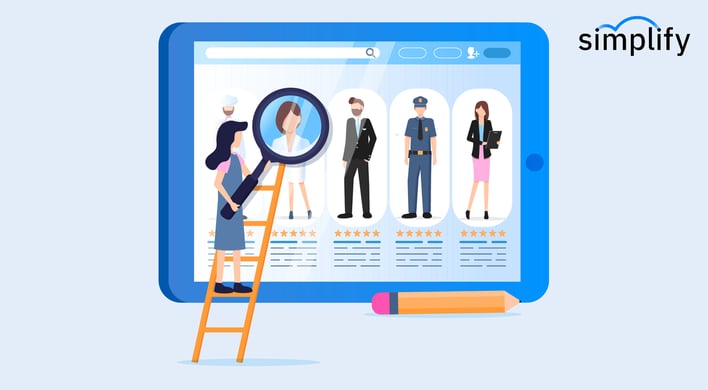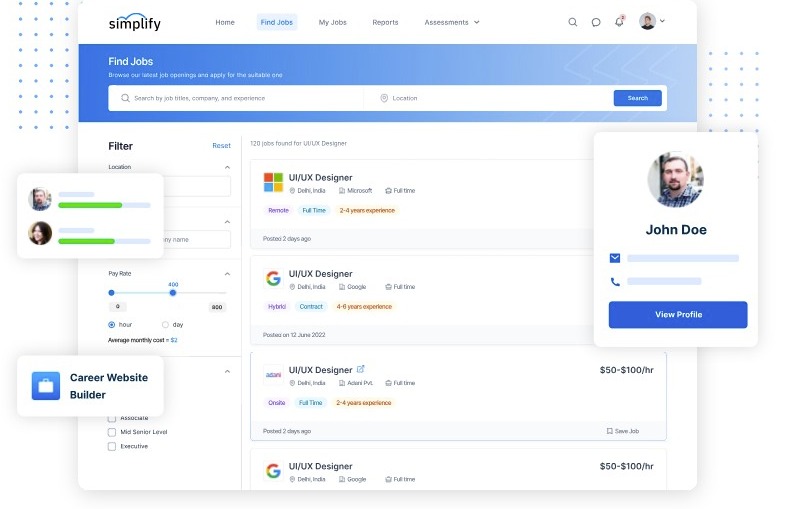Can Direct Sourcing Improve the Quality of Hires?

Are you seeking to hire top-notch talent for your organization without breaking the bank or dedicating excessive time to the process?
The first thing that you need to do is to set up the right approach.
Picture this: hiring people for a job is like choosing between two roads. One road is the old, familiar path we’ve always taken - relying on others to find the right person, waiting for responses to job postings, and hoping for the best.
The other road is new, different, and exciting. Here, companies take charge themselves, using smart methods to find exactly the right fit for their team.
If you choose the second route, you can revolutionize your recruitment strategy.
Let’s understand exactly what this new approach to hiring is.
Decoding Direct Sourcing
The old way of hiring is well-known. Companies often ask specialized hiring agencies to put up job ads across various platforms and then wait to see who applies. It’s like throwing a big net into the ocean and crossing your fingers that the right fish swims in.
![info506 [Converted]-02 1](https://insights.simplifyvms.com/hs-fs/hubfs/info506%20%5BConverted%5D-02%201.jpg?width=2480&height=1412&name=info506%20%5BConverted%5D-02%201.jpg)
But now, with a wealth of state-of-the-art software and analytics available on the market, an innovative approach to hiring is often termed ‘Direct Sourcing’.
In simple words, Direct Sourcing is a recruitment process where an organization recruits resources directly instead of relying on external hiring or staffing agencies.
Direct sourcing recruitment has several advantages over the legacy hiring process, and it accounts for data-driven talent acquisition. That means using insights and stats to identify the ideal candidate.
Recruiting teams leveraging data to create hiring plans can dramatically reduce costs, save time, and enhance the workforce.
Without further ado, let’s understand how you can imply direct sourcing straightway to transform your hiring process.
How Can You Advocate Smart Recruiting Using Direct Sourcing?
The ability to attract talent with the power of your brand can truly transform your hiring process. Let’s discover some proven ways of smart recruiting through direct sourcing.
#1. Social Media
Brands can leverage social media platforms like LinkedIn to identify potential candidates.
This can be done by posting interesting job ads and sharing pictures and videos regarding the company culture.
Plus, brands can provide comprehensive job descriptions, ensuring candidates understand the organization’s expectations and requirements.
%20Search%20all%20Jobs%20_%20LinkedIn.jpg?width=1123&height=508&name=Screenshot%20of%20(22)%20Search%20all%20Jobs%20_%20LinkedIn.jpg)
In this way, ideal candidates approach your brand instead of you having to actively search for the right talents.
#2. Build a Career Page
Establishing company-branded career pages not only boosts brand loyalty and value but also automates job postings across various job boards.
You can develop impressive career pages on your site with assistance from top direct sourcing solutions providers.

Additionally, direct sourcing solutions provide in-depth analytics on hiring campaign performance, candidate matches, and the quality of hires.
#3. Employee Referrals
Referral programs are very effective. When current employees recommend someone for a job, they often bring in the right fit. This is because they know the person well and understand if they fit the company’s requirements.

Plus, it’s quicker and cheaper to hire through employee referrals. New hires from these referrals tend to join the team smoothly and work well with others, making the workplace a more enjoyable and cooperative space.
Now that you completely understand how to use direct sourcing, it’s time to unleash data-driven recruiting.
What is Data-Driven Talent Acquisition?
In the world of hiring, data-driven recruitment stands as a game-changer. It’s a smart way of picking candidates based on facts, not just gut feelings. Unlike the traditional methods that rely on hunches, this approach dives deep into numbers and patterns to find the perfect candidate.
By harnessing the true potential of data, organizations gain a lot of valuable insights to enhance their recruitment process and make data-driven decisions.
The advent of advanced recruitment solutions makes it easier to advocate data-driven talent acquisitions.
How to Incorporate Data into Your Direct Sourcing Recruitment Process?
Considering the significant advantages of data-driven recruitment, it’s evident that this approach is here for the long haul. Nevertheless, teams must adopt it effectively to harness its rewards.
Therefore, below are the essential practices you should follow when integrating data into your direct sourcing recruitment process.
#1. Choosing the Right Metrics
Selecting the right metrics and appropriate data sources is crucial in data-driven recruitment. When utilizing recruitment analytics, a vast amount of data is gathered from different stages of your hiring process.
The abundance of data can make it challenging to pinpoint which data points are the most essential.
One of the most tracked metrics is the quality of hire. It reflects the overall effectiveness of your hiring process.
You can begin by examining this metric and expand to consider other metrics such as:
- The total time taken to hire a candidate starting from discovery to successful onboarding of the candidate.
- The total expense incurred in hiring a candidate.
- The total time taken to recruit a candidate.
- Job offers acceptance rate.
You can leverage top hiring tools to monitor all these important metrics.
#2. Create Recruitment Dashboards
Possessing all the collected data won’t be helpful unless you know how to utilize it effectively. This is why it’s crucial to develop a recruitment dashboard.
It helps in visualizing the data, spotting trends, and recognizing potential issues in your hiring process before they become troublesome.
By using a recruitment dashboard, you can organize the gathered data into categories like hires, budgets, applications, campaigns, and more.
#3. Leverage Data to Enhance Hiring Performance
The data-driven recruitment process isn’t complete unless you take actions based on the collected data.
Here are some common hiring issues that you can eliminate by using data:
Longer Hire Time - If your hiring process takes longer than the industry standard then you need to check which stages are causing delays.
- Sourcing Stage: Expand your sourcing methods using tools to reach candidates quicker.
- Screening Stage: Add more qualifying questions to applications and screen applicants effectively.
- Interviewing Stage: Leverage scheduling software to organize interviews efficiently.
- Job Offer Stage: Create attractive offer letters highlighting the roles accurately to entice applicants.
Lower Job Acceptance Rates - If top candidates decline job offers, it leads to higher costs and unfilled positions.
- Research competitive salaries and benefits to create compelling job offers.
- Engage with candidates early to figure out their interests and concerns.
- Ensure a positive candidate experience by ensuring timely communication and a comfortable interview process.
Higher New Hire Turnover - If new hires leave quickly, you must repeat the hiring process, which is frustrating and time-consuming. To avoid this, you must:
- Communicate the job’s duties and expectations before hiring.
- Implement an effective onboarding process to make new hires feel comfortable and engaged right from day one.
- Provide proper training and induction to every new candidate joining your organization.
These data-driven strategies aim to address specific hiring issues, improving overall recruitment outcomes.
Wrapping Up
In today’s competitive job market, harnessing data-driven recruitment methods has become imperative for securing top talent efficiently. Through the strategic use of data, businesses transform their hiring landscape. The combination of direct sourcing and a data-driven approach will revolutionize the recruitment process shortly.
We hope you really enjoyed reading this article, if that’s the case then you’ll surely love the following resources on vendor management software:
- Top 6 Reasons Why You Should Invest in a VMS
- 7 Questions You Must Ask Before Investing in a VMS
- Top 25 Strategic Interview Questions to Ask Candidates
Frequently Asked Questions (FAQs)
- What is Direct Sourcing in recruitment?
Direct Sourcing is a recruitment approach where organizations directly recruit resources without relying on external hiring or staffing agencies. This method often involves leveraging state-of-the-art software and analytics to identify and attract the right candidates. - How does Direct Sourcing differ from traditional hiring methods?
Unlike traditional methods where companies rely on hiring agencies to post job ads and manage applications, Direct Sourcing empowers organizations to take charge of their hiring process. It involves using smart methods, such as social media outreach, building career pages, and employee referrals, to attract talent directly. - What are the benefits of Direct Sourcing?
Direct Sourcing offers several advantages over traditional hiring methods. It allows organizations to save costs, reduce hiring time, and enhance the quality of hires by leveraging data-driven talent acquisition strategies. - How can social media be used for Direct Sourcing?
Social media platforms like LinkedIn can be utilized to identify potential candidates by posting job ads, sharing company culture content, and providing comprehensive job descriptions. This approach encourages ideal candidates to approach the company
directly, streamlining the recruitment process. - What role do employee referrals play in Direct Sourcing?
Employee referral programs are highly effective in Direct Sourcing as current employees can recommend candidates who are a good fit for the company. This method tends to result in quicker and cheaper hires, as referred candidates often integrate smoothly into the team and align well with the company culture. - What is Data-Driven Talent Acquisition?
Data-driven talent acquisition is an approach to recruitment that relies on factual insights and analytics rather than gut feelings. It involves using data to identify patterns, make informed decisions, and continuously improve the hiring process for better outcomes. - How can organizations incorporate data into their Direct Sourcing recruitment process?
Organizations can incorporate data into their Direct Sourcing recruitment process by selecting the right metrics, creating recruitment dashboards for visualization and analysis, and leveraging data to enhance hiring performance. This includes optimizing processes to reduce hiring time, improve job offer acceptance rates, and minimize new hire turnover. - What are some common hiring issues addressed by data-driven strategies?
Data-driven strategies aim to address common hiring issues such as longer hire times, lower job acceptance rates, and higher new hire turnover. By analyzing data and taking targeted actions, organizations can streamline their recruitment process, create compelling job offers, and improve the overall candidate experience. - Why is data-driven recruitment essential in today's job market?
In today's competitive job market, data-driven recruitment is essential for securing top talent efficiently. By harnessing data, organizations gain valuable insights that enable them to make informed decisions, enhance their hiring process, and stay ahead of the competition. - How does the combination of Direct Sourcing and a data-driven approach revolutionize the recruitment process?
The combination of Direct Sourcing and a data-driven approach revolutionizes the recruitment process by empowering organizations to take control of their hiring, attract the right candidates more effectively, and continuously improve their recruitment strategies based on actionable insights and analytics.

-1.png?width=352&name=MicrosoftTeams-image%20(3)-1.png)
-1.jpg?width=352&name=image%20(7)-1.jpg)

Your comments